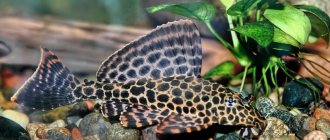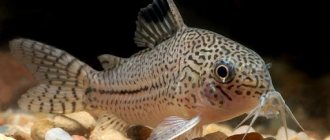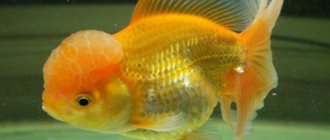If you decide to buy an aquarium, then the first fish you should buy is a catfish. They are very good orderlies who clean the bottom of mucus. There are a large number of species of aquarium catfish, the size of which can range from a few centimeters to a couple of meters. The structure of their body is quite unusual, which makes catfish a favorite of many aquarists. In order to introduce catfish into your aquarium, you must know what kind of care they require, the peculiarities of their maintenance and compatibility with other fish.
Appearance Features
Catfish are freshwater inhabitants that live on all continents except Antarctica. All catfish have a number of common characteristics that allow them to be accurately identified among other fish. Among catfish there are species of different sizes - from miniature to giants weighing more than 100 kg.
General external signs of catfish:
- no scales;
- large head, wide and flattened;
- on the muzzle there are several pairs of whiskers;
- relatively flat body, tapering towards the tail;
- The color is often neutral, matching the color of the bottom.
Aquariums today usually contain hybrid catfish, bred through selective breeding. The fish are distinguished by their beautiful colors or veil fins.
Ground and shelters
There are also no special requirements or recommendations for the soil. The soil and shelters must be in the aquarium, since catfish are bottom dwellers. It could be anything: plants, decorative figures or some kind of driftwood, fish houses. If you have plants in an aquarium, pay attention to artificial options, as real catfish will quickly eat them.
If the fish have nowhere to hide and be alone, they will be in a state of stress, their appetite will worsen and its lifespan will be shortened.
Character and behavior
Catfish can adapt to a wide variety of conditions. They are hardy, unpretentious, and able to repel the attack of large fish. They themselves are calm and non-aggressive. Many species of catfish are ideal for life in an aquarium.
Among catfish there are both predators and species that prefer to feed on small invertebrates, algae, and detritus. In an aquarium, catfish are usually found in the lower layers, eating food that has sunk to the bottom. Because of this feature, catfish are called orderlies or aquarium cleaners.
Features of the behavior and character of catfish:
- prefer not to stray far from their hole;
- love to live and hunt alone;
- are active at night or closer to dawn;
- young fish feed mainly in shallow water, not far from the shore;
- the day is spent in the den;
- in warm weather they can get out of holes and slowly ply in the water, enjoying the warmth and sun;
- prefer to live in clean water;
- react to strong odors.
The fry stay in schools. The same can be said about young catfish. If there is enough food, fish can stay in groups for up to 3-4 years. Then they begin to live alone, each individual has its own feeding territory and defends it.
Popular types of aquarium catfish
About 2000 species of catfish are known, many of which can be kept in an aquarium. Among them, aquarists have clear favorites - beautiful, spectacular, unpretentious in maintenance.
Ancistrus
This is one of the most popular aquarium catfish, which is also called sticky. Family - chain catfish. Body length is up to 15 cm. In the aquarium, they eat algal fouling on aquarium glass, decorations, and plant leaves.
Ancistrus have a body covered with bony plates. The oral sucker is well developed. Mature males have projections on their heads - they are called tentacles. In a common aquarium they behave quietly and pay almost no attention to their neighbors.
Features of keeping ancistrus:
- there must be driftwood in the aquarium - they are sources of cellulose, necessary for the proper functioning of the gastrointestinal tract of catfish;
- The basis of the diet is plant food - dry sinking tablets.
Agamix
The agamix star catfish grows up to 17 cm in length in nature, and up to 12 cm in an aquarium. It has a large triangular head and 6 spotted whiskers. The body is covered with dense plates and ends with a narrow tail. The dorsal fin is triangular, the first ray is serrated.
The pelvic fins are small and covered with spines. The body is black or brown, with yellow spots that turn into stripes on the tail. Agamiks are often called singing or grumbling - catfish can make cracking sounds.
Features of agamix content:
- in one aquarium you can keep a flock of 4-6 catfish;
- the minimum tank volume for a group is 100 l;
- You cannot fill water to the brim - the catfish must rise to the top to grab air for intestinal respiration.
Corridoras
Aquarists love Corydoras for their hard work. These fidgets endlessly scurry around the aquarium, looking for food at the bottom. The size of the fish is 3-12 cm. Their character is peaceful and calm. They are considered one of the most hardy and unpretentious species. They are recommended for beginner aquarists.
Corydoras' body is short, flattened, with a convex back. The color is multi-colored, spotted, with a golden or olive tint. The body of Corydoras has a metallic sheen. There are species with stripes, albinos.
Features of the maintenance of corridors:
- place in flocks in aquariums from 60 liters;
- the soil should be made of fractions without sharp edges - so that the fish do not damage their sensitive whiskers;
- the aquarium must have good aeration and filtration;
- They are not picky about food, they eat any food that falls to the bottom.
Hypancistrus
Hypancistrus are the closest relatives of Ancistrus. They come from South America, and many species are endemic to their water bodies. There are several types of hypancistrus, and all of them have an original color - striped or spotted. They are characterized by low fertility.
Many species of hypancistrus end up in aquariums before ichthyologists describe them and assign a name. These catfish are given a number starting with the letter L (short for Loricariidae). These fish are usually called L-catfish or numbered catfish by aquarists.
Features of keeping hypancistrus:
- prefer food of animal origin;
- do not stick to surfaces to eat fouling, but pick up food from the bottom;
- lead a twilight lifestyle;
- need shelters to hide during the daytime;
- Do not plant dense thickets in which catfish can become entangled.
Endemics are representatives of flora or fauna that are found in one specific place - territory or body of water. They are unique and not very numerous. Many endemics are listed in the Red Book.
Loricaria
One of the most interesting representatives of the chain-mail catfish family. They have an unusual appearance and can adapt to a wide variety of conditions. They get along well with other inhabitants of the aquarium.
The catfish has an elongated thin body. Length - up to 12 cm. Second name - whip catfish. Pisces are peaceful, spending a lot of time in shelters. It is not recommended to house them with aggressive species.
Features of keeping loricaria:
- an aquarium of 40-150 liters is required;
- you can keep loricaria alone, in pairs or in groups;
- They eat up the remains of food left uneaten by other inhabitants of the aquarium.
Torakatum
These aquarium catfish have a peaceful disposition and secretive nature. Torakatums, unlike most catfish, are active and do not hide in snags all day long. They constantly move in the bottom layer, scurry between stones and decorations, looking for something edible.
The body length of the catfish is 12 cm. There are 2 rows of protective plates on the body. Body color is brownish, spotted.
Features of keeping thoracatums:
- get along well with neighbors;
- by collecting leftover food from the bottom, they help maintain the cleanliness of the aquarium;
- It is recommended to dim the light with algae floating on the surface of the water.
Before spawning, male thoracatums build special nests - bubble nests. This feature is not typical for catfish. This behavior is more typical of labyrinth fish.
Pangasius
In appearance, pangasius, especially from the high-finned group, resemble sharks. Popularly, the species is often called shark catfish. The similarity is added by the shape of the fin. With sufficient aquarium volume, pangasius grows up to 1 m in length.
The body color is dark gray, turning into light gray on the sides and belly. Pangasius, although menacing in appearance, is very shy.
Content Features:
- It is recommended to keep in large aquariums of 1000 liters or more, decorated in a pseudo-marine style - with corals, pebbles, “sunken treasures”;
- space for movement is required;
- even cleaning the aquarium can become stressful for pangasius - the fish begin to hit the walls of the aquarium, trying to jump out;
- To prevent jumping out, equip the aquarium with a lid.
Otocinclus
The smallest species of Loriacari catfish. Their length does not exceed 3 cm. But their small size does not interfere with hard work and activity - catfish diligently fight against aquarium lower algae. The coloring of otocinclus is varied, there are species with spots, a golden tint, and stripes.
Features of keeping otocinclus:
- suitable for nano-aquariums - a 40 liter tank is enough for them;
- It is not recommended to live next to aggressive and large fish.
Pterygoplichthus
Spectacular spotted catfish look like real giants in the aquarium world. They grow up to 50 cm in length. They have a leopard print coloration and a fan-shaped dorsal fin. In appearance, these chain-mailed catfish look intimidating, but in fact they are very peaceful.
Features of keeping pterygoplichts:
- designed for large aquariums - from 250 l;
- In order for the catfish to be non-aggressive towards its neighbors, it needs a lot of free space for swimming;
- the diet is based on plant foods; catfish regularly scrape algae from glass, stones, and driftwood, keeping the aquarium clean;
- It is not recommended to live next to small species of fish - catfish can eat them, even by accident;
- The optimal food is special tablets with spirulina.
Sinodotis
These African catfish will appeal to lovers of medium and large fish. If you place them in a large aquarium, they will be able to get along safely even with aggressive cichlids (but it is advisable to raise them together from a young age). Synodontis will eat small fish.
Body length is 20-30 cm. They can swim upside down, which is why they are often called catfish-shifters. All varieties are extremely impressive. The colors often have stripes and spots. The fins are dorsal and caudal, well developed, often with a veil.
Features of the content of synodontis:
- you need an aquarium with a volume of up to 150 liters;
- good filtration and aeration are necessary;
- They are unpretentious in food and happily eat dry catfish food.
Synodontis have an interesting feature - parasitic spawning. Catfish throw eggs to cichlids, which incubate them in their mouths. Since synodontis eggs develop much faster, their fry, upon hatching, immediately destroy the cichlid eggs.
Platidoras
Spectacular catfish with striped colors. They are popular among aquarists, but their spread is largely hampered by their incompatibility with most aquarium species. You cannot keep fish that can fit in their mouths with predatory platidoras.
A special feature is the ability to “sing”. Platidoras catfish can make chirping or percussive sounds. This usually happens at night or when the fish is scared. Body length - 20-24 cm. The body has black and white longitudinal stripes.
Features of keeping platidoras:
- Possible keeping with medium and large fish;
- During the day, platidoras hide in shelters; they emerge only at night;
- It is recommended to settle in aquariums from 100 liters.
general description
The number of species of aquarium catfish is huge. There are miniature species, not exceeding 2-3 cm in length, and large fish, reaching up to 40 cm or more. The colors of catfish are very different.
External characteristics and behavioral features common to all catfish:
- The abdomen is flattened, allowing the fish to move comfortably above the bottom soil.
- There are sensitive whiskers near the mouth that help to navigate in space and grope for food.
- Absence of scales on the body.
- Many species have sharp fin spines and bony plates on the body.
- Bottom lifestyle.
- Activity in the dark.
Aquarium catfish are not capricious in maintenance and care. It is enough to create standard conditions for them so that they live long, remain healthy and active. In good conditions, pets live on average 8 years - this is a considerable age for freshwater inhabitants.
Necessary conditions of maintenance and arrangement of the aquarium
Aquarium catfish are unpretentious bottom-dwelling fish. They are quiet and hardy, maintaining the cleanliness of the aquarium, but for them it is necessary to create certain conditions appropriate to their size and lifestyle.
Volume
Catfish need an aquarium with a wide bottom so that they have room to roam. The height of the reservoir is of secondary importance, since catfish spend most of their lives in the bottom layers. Round aquariums are not suitable for catfish; these fish need room to move.
The volume of the tank depends on the size of the catfish and their number. If we are talking about small species ranging in size from 2 to 7 cm, a 50-200 liter aquarium is enough (for a couple of fish). Large catfish require a container of 500 liters or more.
Decor
In the aquarium with catfish, shelters are installed - driftwood, artificial caves and grottoes. They are necessary to create a comfortable environment - most catfish prefer to hide all day. As night falls, rested but hungry catfish come out to feed.
Water
Catfish are kept in clean, unsalted water, since in their natural environment fish live in fresh water bodies. They have cutaneous respiration and can breathe regular air. For this reason, they go up to replenish their oxygen supplies. Catfish are undemanding to the oxygen regime.
Optimal water parameters in an aquarium with catfish:
- temperature - +22...+28°С;
- acidity - 6.5-7 pH;
- hardness - 6-12 ºdH.
Lighting
Most aquarium catfish prefer to stay awake in the dark. They do not require any additional lighting. Catfish are comfortable with dim light. If partial shade is constant, night hunters appear “in public” during the daytime.
Plants
The choice of plants depends on the type of catfish. If the aquarium contains vegetarian catfish, it is better to plant artificial vegetation, as they quickly eat the real thing.
In aquariums with predatory catfish, plant plants with strong roots, since the fish love to burrow in the ground. It is advisable to use special pots for aquatic vegetation.
Priming
Catfish have no special requirements for soil. If the species is prone to digging, fine sand is not recommended. This will avoid turbidity in the water. The best options are coarse sand, rolled small pebbles, and marble chips.
Bulk materials with fractions that have sharp edges cannot be used as primer. Otherwise, catfish may injure their sensitive whiskers.
Equipment
In nature, catfish often live in oxygen-rich waters with strong currents. The aquarium must have a filter that creates a flow of water. The presence of aerators is less important, since catfish can use oxygen from the atmosphere to breathe.
The recommended filter is a bottom filter, mechanical type. It is better to mount it outside the aquarium. Catfish love warmth. Install a thermometer and heater in the aquarium.
Watch the following video for 25 tips on keeping catfish in an aquarium:
Diseases and prevention
Catfish have a strong body; infectious diseases are rare. The reasons why catfish die in an aquarium may be sudden fluctuations in water temperature and exceeding the permissible concentration of nitrogen compounds. Some species are sensitive to a complete change of water.
Disease prevention involves regularly replacing water and maintaining optimal conditions. Infectious diseases require the use of medications recommended by a veterinarian, but it must be taken into account that aquarium catfish cannot tolerate salt- and copper-containing medications.
Catfish are not only one of the most popular fish with an original appearance, but also cleaners that benefit the aquarium. It is interesting to watch how a large and active fish slides its belly along the bottom and walls of the tank, looking for food. From the many species of catfish, every aquarist can choose an unpretentious and beautiful pet according to his preference.
Nutrition issues
The diet of catfish is significantly different from that of most aquarium fish. When choosing food and regimen, take into account the individual characteristics of a particular species.
What does catfish eat?
Most catfish are omnivores, but there are species among them that prefer animal or plant food. A variety of foods are used to feed them - dry, frozen, freeze-dried. An optimal diet should contain plant and animal foods.
It is recommended to feed catfish:
- raw fish;
- shrimp and other seafood;
- herbs and vegetables;
- flakes and tableted catfish feed.
If there are other fish in the aquarium besides catfish, you don’t have to feed the catfish specially. They pick up leftover food that sinks to the bottom, and at the same time clean the aquarium.
Feeding frequency
Catfish fry are fed 2-3 times a day plus feeding at night. For adult predatory catfish, a single meal is enough. Food is given in anticipation of the night, turning off the lights. Herbivorous catfish have to be fed more often - 3-4 times a day.
Breeding catfish
If you only have catfish in your aquarium, don't worry, you don't have to do anything. And if you have mixed fish, it is better to transplant the catfish into a separate container with clean water, preferably the volume is 30-40 liters.
Usually for one female it is enough to choose 3-5 males. It is necessary to provide their new place of residence with algae and soft soil.
To make the catfish feel comfortable and begin to mate, change the water every day for several days. The temperature should be 17-15°C. Saturate the water with oxygen more often. You can place the aquarium in a dark place or cover it with something, since catfish do not mate during the day. If you follow all the rules, you will see results in 5-7 days.
Reproduction
The breeding scheme for aquarium catfish is determined by their species and depends on the method of incubation, spawning characteristics and other factors. Some species of catfish can breed in a community aquarium, others require a separate spawning tank, and others do not breed at all in captivity or only after a hormonal injection.
How to distinguish a male from a female?
Sexual dimorphism in catfish is not particularly pronounced, but it makes it possible to distinguish males from females. The latter look more presentable in most species.
Features:
- in females, the fin on the back is shorter and rounder;
- females are larger than males;
- males have whiskers (growths) on their faces, females do not;
- males have brighter colors;
- in males there is a small tubercle near the anus, in females there is a depression.
Each species of catfish, in addition to the above characteristics, has its own characteristics of sexual dimorphism, characteristic only for them.
Preparing for mating
Catfish usually reach sexual maturity at 8 months. Starting at this age, catfish can successfully mate and reproduce.
To stimulate the reproduction of catfish, raise/lower the temperature in the aquarium by a couple of degrees. This is easy if catfish live in a species aquarium where there are no other fish representatives. Otherwise, you have to take into account the temperature preferences of your neighbors.
If catfish are kept in a common aquarium, it is better to transplant the spawners into a separate tank - a spawning tank. And in it, without interfering with the comfort of other fish, create an environment favorable for reproduction.
Requirements for the spawner:
- The minimum volume is 30-70 liters, depending on the size of the catfish.
- It is necessary to have shelters - caves, grottoes, natural snags.
- Plant plants and install an aerator.
Choose the healthiest and strongest individuals as breeders and provide them with a balanced diet. It is recommended to choose a female larger than the male.
Breeding offspring
Male catfish first demonstrate their location to the female - they circle around their partner, lightly touching her with their whiskers. When the female is ready to mate, the male takes her to a secluded corner to breed.
Features of catfish reproduction:
- Spawning for almost all catfish lasts about 5 days. During this time, the catfish chooses a place to spawn. The female lays eggs and the male fertilizes them. During this time, the female lays up to 200 eggs.
- When the female has spawned, the breeders can be returned to the community aquarium. Immediately increase the temperature in the spawning tank to +27...+28°C. Sometimes only the female is hatched, and the catfish is left to take care of the eggs - the details depend on the specific type of catfish. During this period, the male protects the clutch and is able to get stressed from any interference. The aquarist should not disturb the catfish by improper cleaning or other active actions.
- After 5-6 days, fry with yolk sacs emerge from the eggs. During the first week of life, the young animals master their habitat. During this period, they can already be given crushed food.
What to feed in the aquarium?
There are no difficulties with feeding catfish in an aquarium. They will find food at the bottom, “in the garden”, and do not disdain small fish that accidentally come into view. But catfish still require a certain menu. Among animal products, frozen or dry, they are offered:
- bloodworm;
- coretra;
- tubifex;
- Cyclops.
Live food must be thoroughly washed before serving.
Vegetable supplements significantly diversify the diet:
- cucumber;
- lettuce leaves, spinach;
- broccoli, asparagus stems;
- pumpkin, zucchini;
- green pea.
Cucumbers
Sometimes you can pamper your pets with well-chopped products from your table:
- lean meat and fish;
- squid;
- boiled eggs.
The fish are fed in the evening, when the catfish begin to be active. We must not forget about vitamin and mineral supplements for bottom dwellers, which, like dry food, are pre-soaked, thereby making the food heavier.
Compatibility
Catfish are large and sometimes dangerous fish. When choosing neighbors, take into account the characteristics of each species - character, size, food preferences.
Different types of catfish
Most catfish are friendly and peaceful, and certainly all of them have a calm character. If catfish have enough food, they do not show aggression. They can be safely placed with their relatives in the same aquarium. The main thing is that the area allows it.
Another condition for the coexistence of different types of catfish is the coincidence of temperament. If you put too aggressive predators and unresponsive herbivorous catfish in the same aquarium, the latter will experience pressure due to territorial claims.
When different catfish live in the same aquarium, the feeding process becomes more complicated. It is necessary to take into account not only the dietary features of each species, but also their temperament when eating food. Some catfish quickly swallow food from the surface, while others patiently wait for food at the bottom.
With other types of fish
When choosing neighbors from other fish species, consider several factors at once. An error or neglect of compatibility leads to a depressed state of the inhabitants of the aquarium, illness and even death - catfish can simply eat them, either intentionally or inadvertently.
The following types of fish should not be kept with catfish: acara, astronotus, and other predatory cichlids.
What factors are taken into account when choosing neighbors for aquarium catfish:
- Water parameters - acidity, oxygen level, hardness. If they do not match, the fish will not be able to live comfortably in the same aquarium.
- Peculiarities of behavior - it is not recommended to house fish with very different temperaments next to each other. Do not, for example, house predator catfish with peace-loving fish.
- Sizes - you should not keep small fish in an aquarium with catfish that can fit in their mouths.
Aquarium catfish, although they prefer to spend most of the day in shelters, remain one of the most beloved among aquarists. These large fish, tirelessly cleaning aquarium surfaces, are extremely interesting to watch, and most importantly, many species can be bred at home.
Male and female: how to distinguish?
Males usually differ from females in color saturation. They are brighter than their friends, their bodies are much slimmer. Males are smaller in size than females, but their mustaches are much longer and thicker. The antennae of females are much shorter or absent altogether.
One of the main differences between boys is their high, long dorsal and pectoral fins, strong gill covers, often decorated with hooks, spines, and needles. Usually the formidable weapon is hidden and camouflaged on the body. When danger arises, warrior catfish instantly bristle with their piercing and cutting weapons. Try it, step up! The girls' equipment does not stand up to competition - the fins are more rounded, smaller in size, and not so warlike.











